Across Cambodia, extraction barges dredge sand from the Mekong River to fuel a construction boom that has dramatically reshaped the capital’s skyline. Yet, while sand has also driven rapid development, it also jeopardises communities whose livelihoods are closely tied to the Mekong.
Scientists have cautioned that excessive sand mining is heightening the risk of the Mekong’s banks eroding and contributing to the shrinkage of Tonle Sap Lake, the world's largest inland fishery. On the ground, mining activities are intensifying competition for river space, as local communities are forced to share their fishing grounds with networks of extraction barges. Families living on the peripheries of the capital’s lakes and wetlands – many of which have already been filled in for real estate developments – face eviction or displacement.
Cambodia's intense demand for sand highlights the critical need to weigh short-term economic gains against the environmental and community impacts on a river already on a knife-edge.
This project was made as part of a collaboration with researchers at the University of Southampton. The series is published in the Royal Geographical Society’s online collection and was also screened as part of the open programme at the 2022 Angkor Photo Festival.
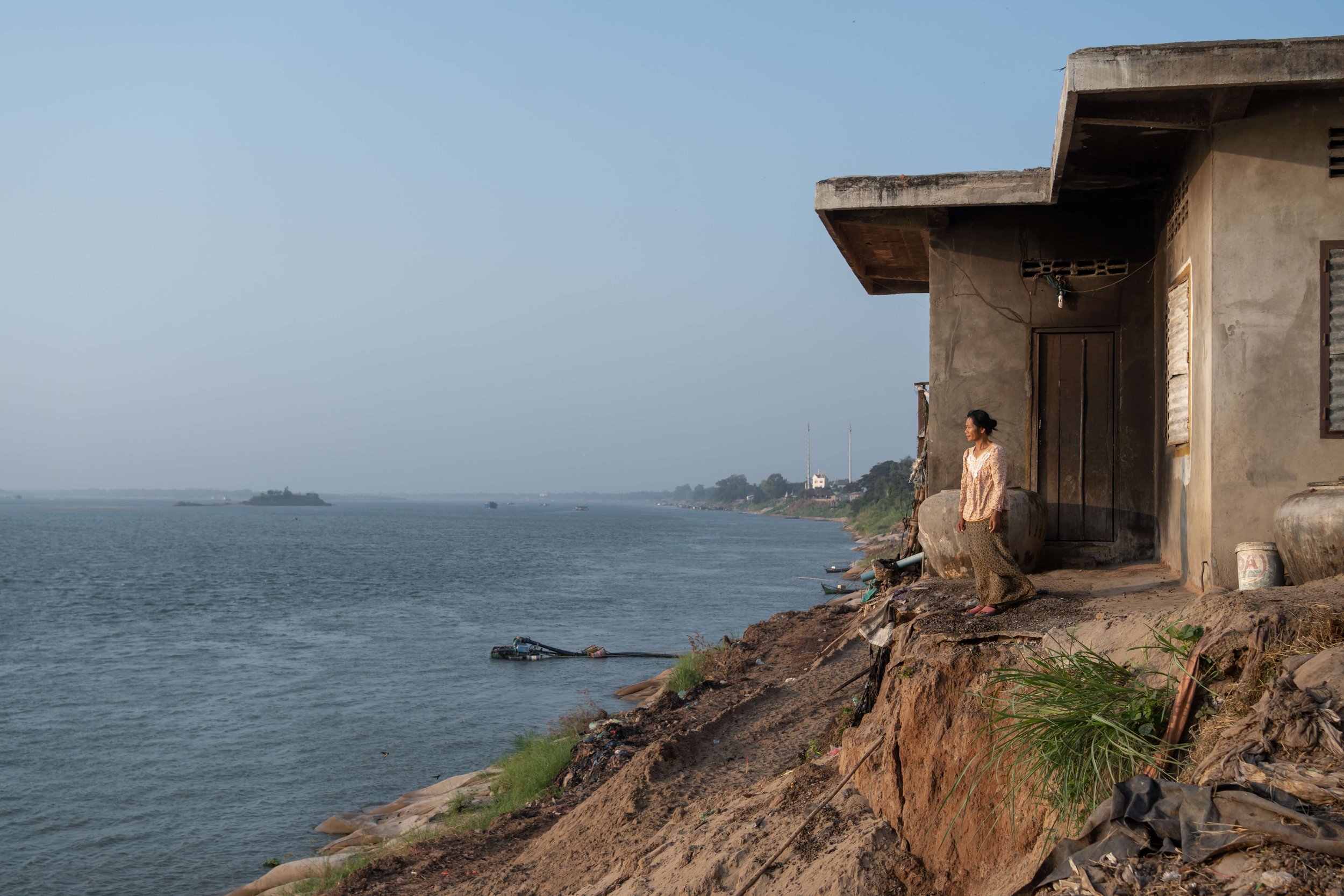
Hak Bopha, a grocery and gravel seller, stands for a portrait behind her house, which was partly destroyed by a riverbank collapse on the banks of the Mekong river. A few hundred metres away, dozens of barges pump sand at Rokar Koang Commune, one of the most heavily mined sections of the river in Cambodia. Bopha says the bigger riverbank collapses are a major threat to her livelihood and only started to occur about four years ago when sand mining began in the area. (Andy Ball/University of Southampton)
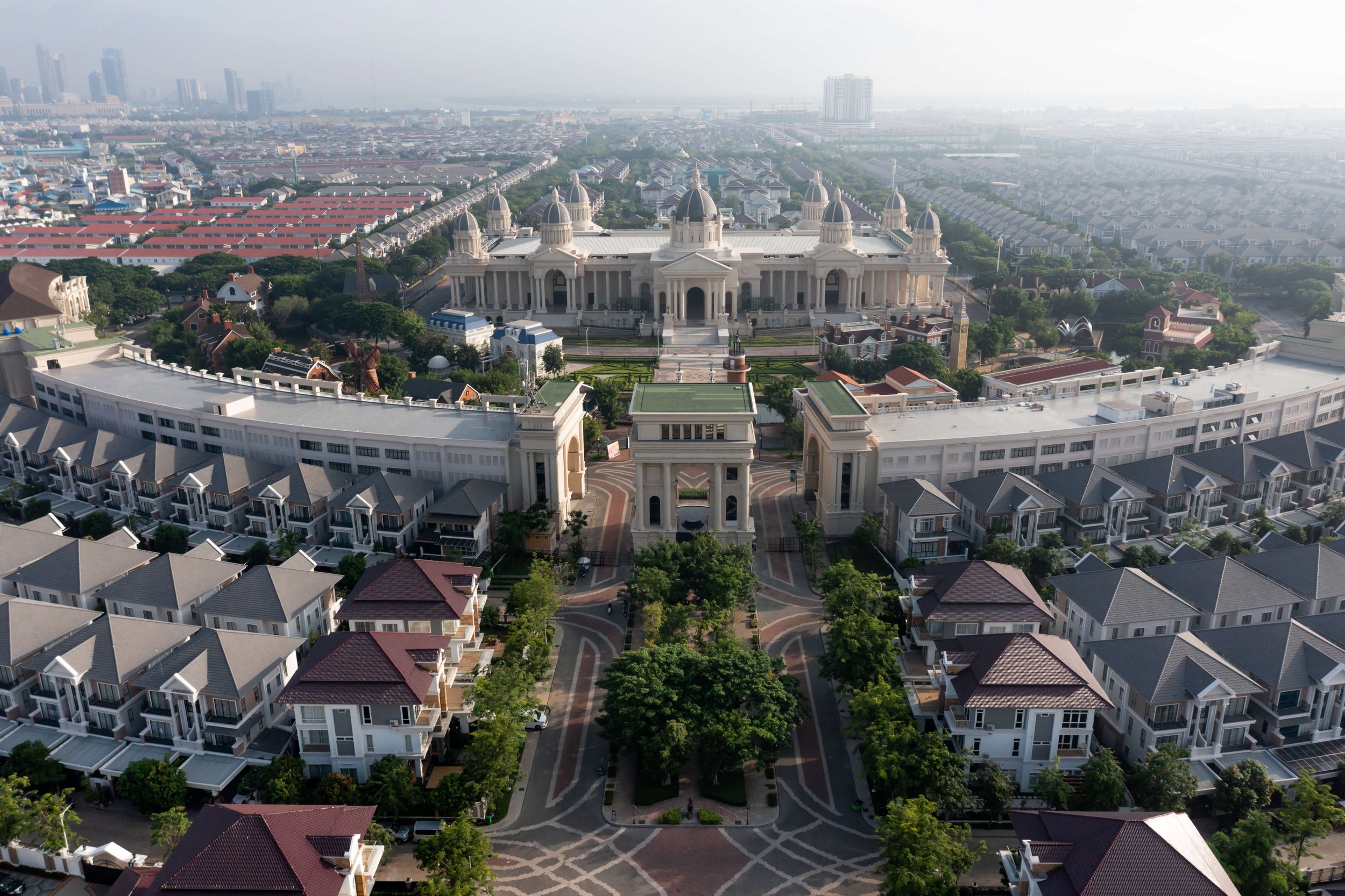
Cambodia’s construction boom has seen gated communities, satellite cities and high-rise condominiums dramatically alter the city’s skyline in recent years, with real estate developers pricing out low-income communities while marketing to the elite of Cambodian society. In the first 11 months of 2021 alone, Cambodia’s construction sector attracted $10.3 billion in investment. The construction boom has led to a rush for sand, a key ingredient in the production of concrete. (Andy Ball/University of Southampton)
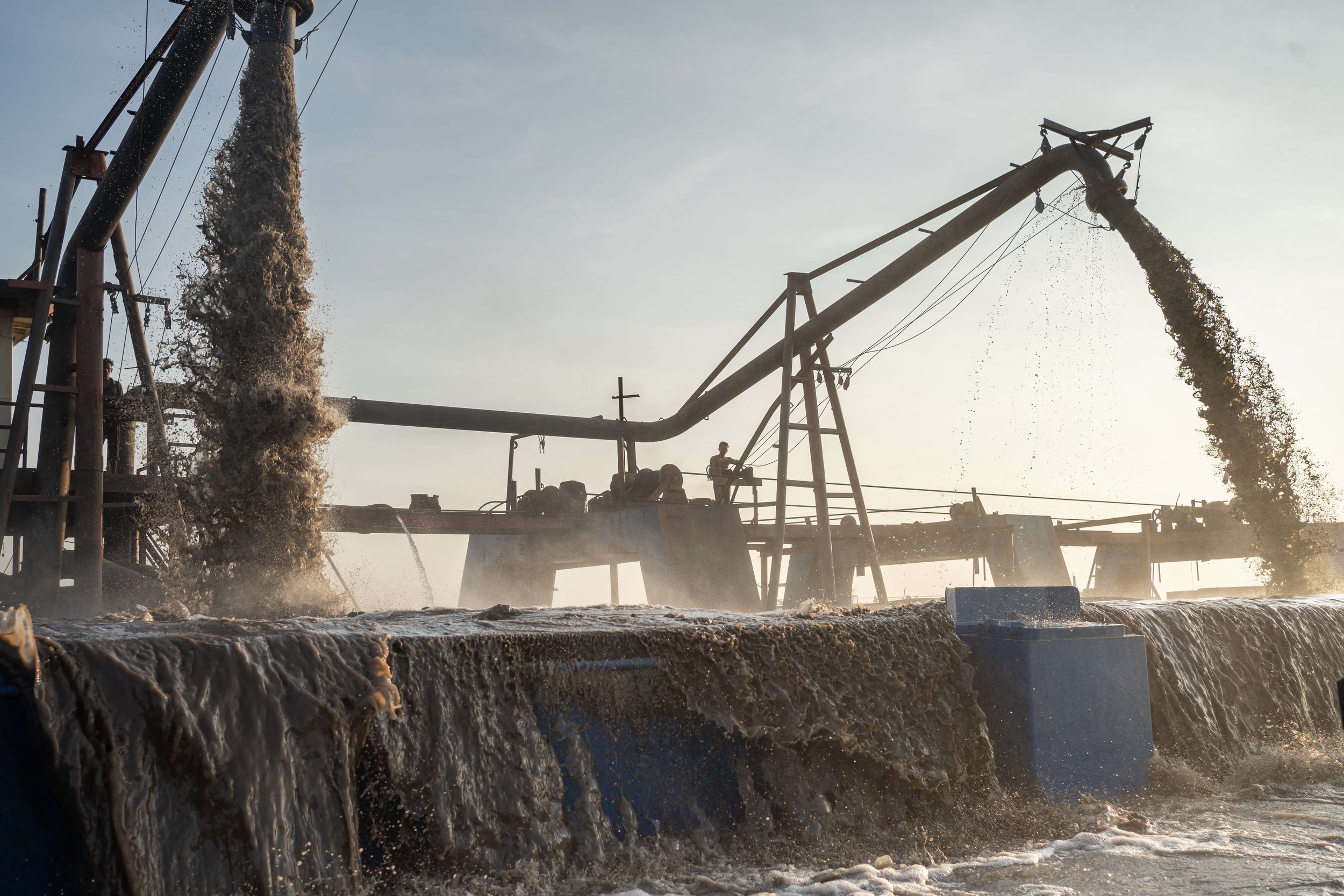
Sand mining barges extract sand from the Mekong, a river that supports the livelihoods of an estimated 60 million people in the region. Research from the team reveals that in 2020 alone, an estimated 59 million metric tonnes of sand was mined from the Mekong in Cambodia, around four times the officially reported figure from the previous year. Cambodia extracts more sand than any other country along the Mekong and at 16 times the natural rate of replenishment. (Andy Ball/University of Southampton)
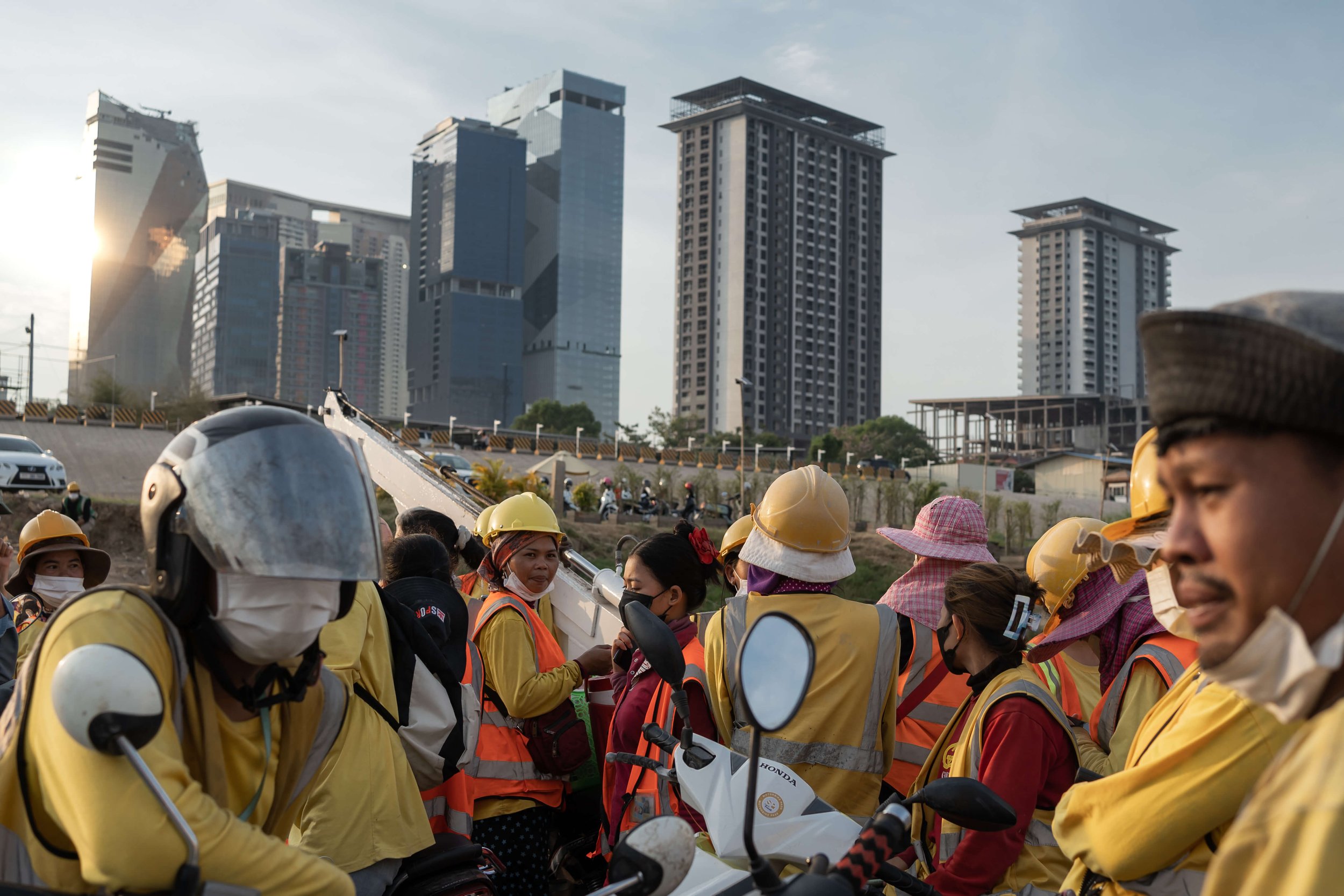
Construction workers take a ferry after finishing work at Koh Pich, or Diamond Island, Cambodia’s first artificial island built on the Mekong. The reclamation project required vast quantities of sand, along with a huge workforce, to create the island and the skyscrapers that dominate it. (Andy Ball/University of Southampton)
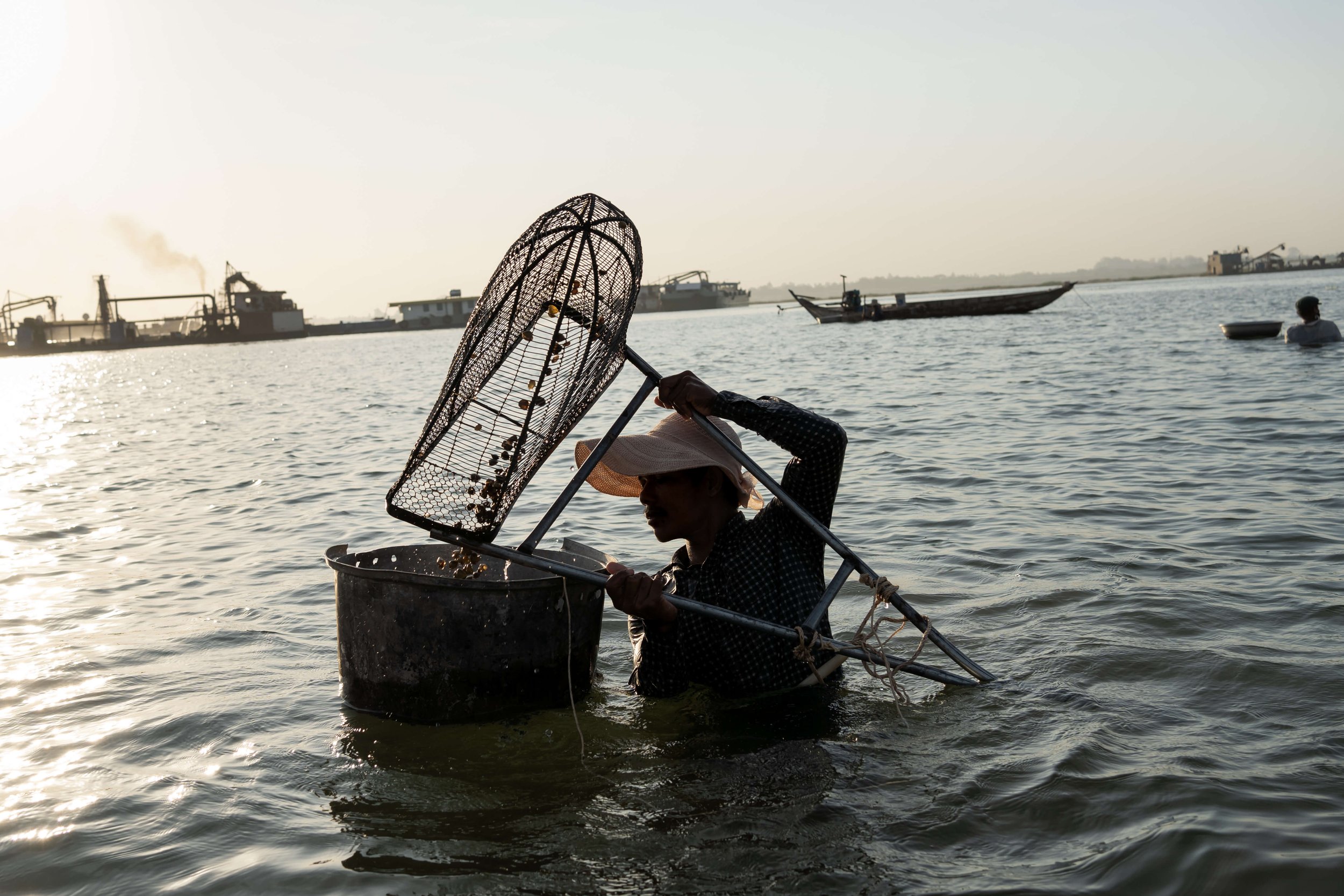
A fisher, who requested anonymity due to fear of retribution from authorities and the well-connected sand mining companies operating in the area, catches snails in the Mekong as sand mining barges work in the background. Before the barges arrived, he used to catch fish like many others in Rokar Koang Commune. However, four years after the sand mining started, catching fish became difficult resulting in many fishers shifting to catching snails or finding work on-land, mostly in construction. Now the sand mining is also affecting the abundance of shellfish too. (Andy Ball/University of Southampton)
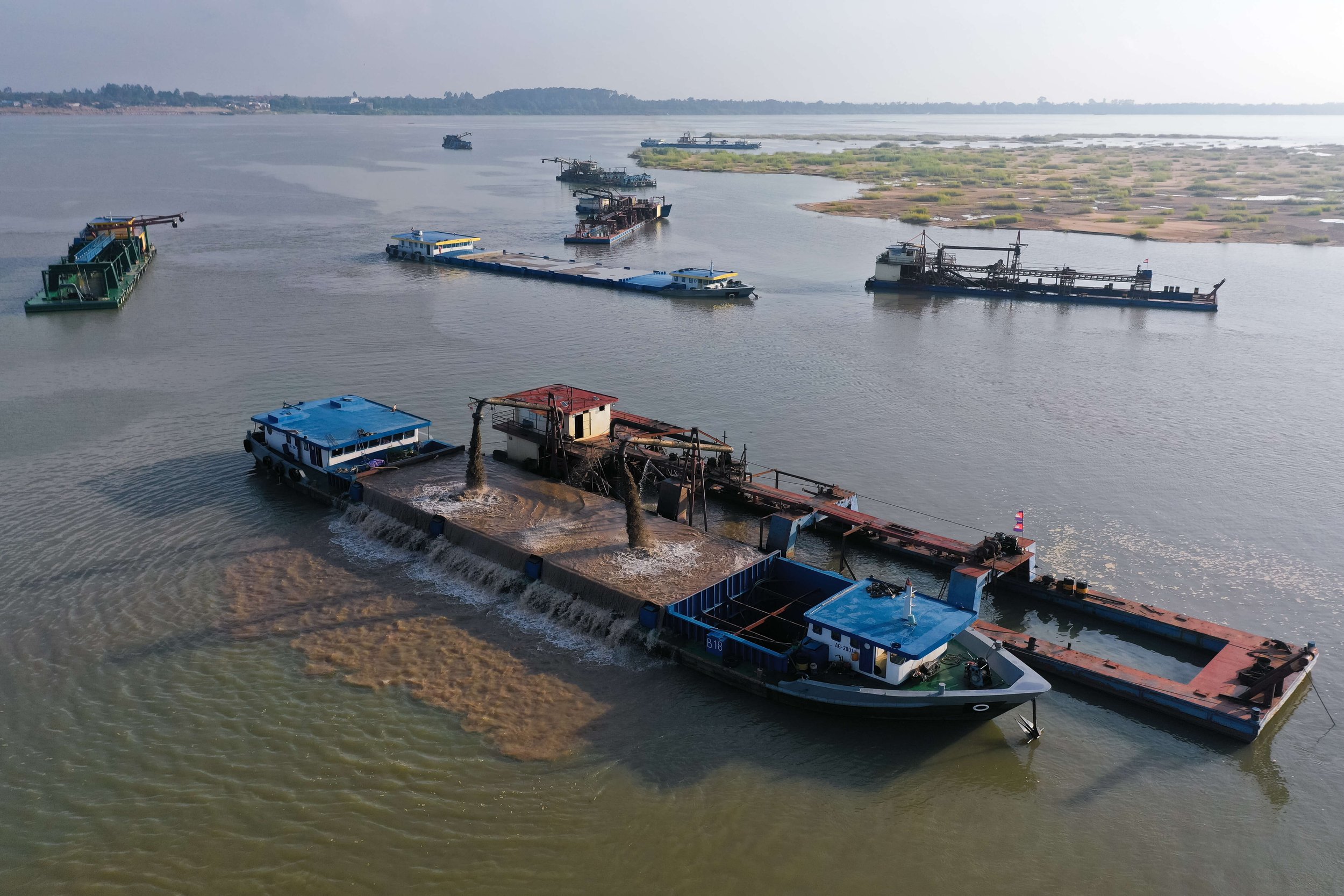
Sand mining barges extract sand in Rokar Koang Commune. Along with being one of the most heavily mined stretches of the Mekong in Cambodia, it was also the site of two riverbank collapses in 2021. The mined sand is shipped to the capital Phnom Penh to be used in construction, reclamation and the filling in of the city’s wetlands. River sand is in high demand in the construction industry due to its angular properties which gives concrete optimum strength. In contrast, despite its abundance, desert sand is rounded and smooth and is not suitable for concrete production. (Andy Ball/University of Southampton)

A photo taken by a local on 23 November, 2021, shows a crack that appeared on the main road that passes through Rokar Koang. Although the banks of the Mekong erode naturally and at varying rates driven by the monsoon flood pulse, other research shows that sand mining activity lowers the riverbed and leads to increases in riverbank instability. (Andy Ball/University of Southampton)
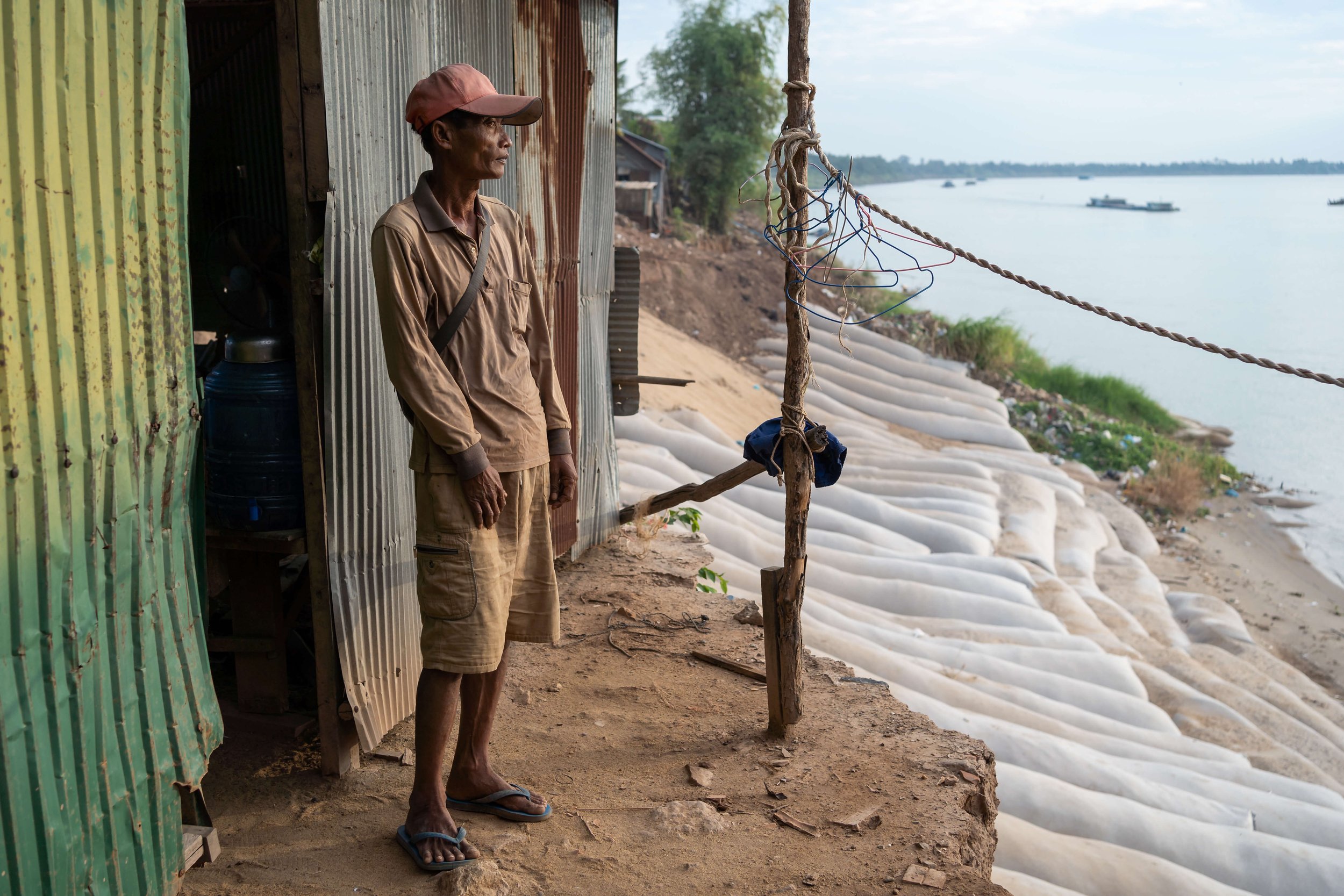
In Chhai Heng, a remorque driver, stands for a portrait at his house next to one of two river bank collapses that happened in 2021 along the same road in Rokar Koang. In the distance, sand barges deliver sand to the capital Phnom Penh. Like many others living in village, when he first moved to live on the riverbank his land extended 50 metres in front of his house. Heng said the riverbank has gradually eroded since the 1990s but when sand mining began in the area, the loss of land accelerated.
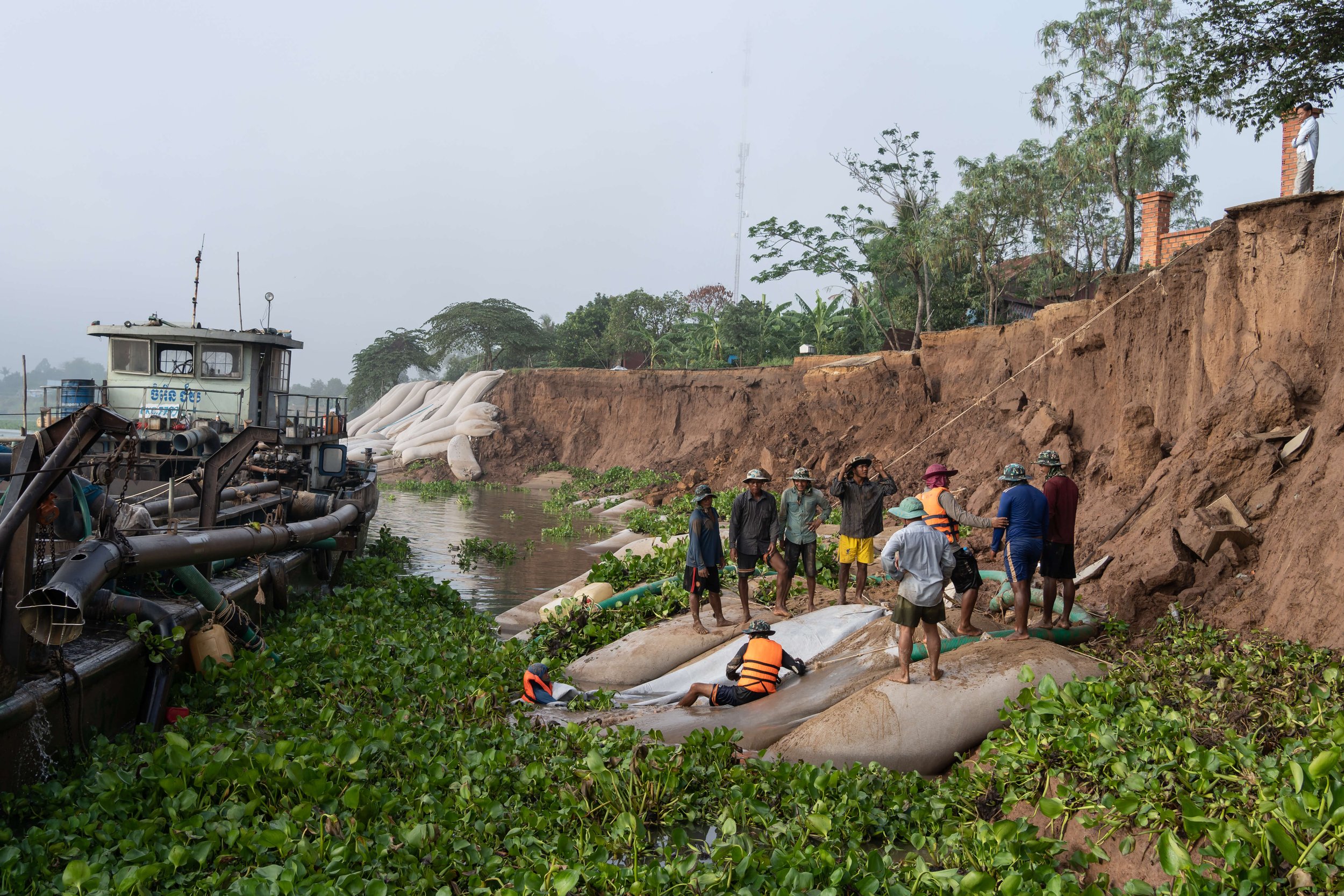
Workers fill bags with sand pumped from the Mekong to protect a very recent riverbank collapse in Boeung Leu village, Kandal Province, from further erosion. Eight families were impacted by the collapse, with four already relocated to the main road in the village. Dozens of families in the village have previously had to relocate as a result of collapses over the last few years. (Andy Ball/University of Southampton)
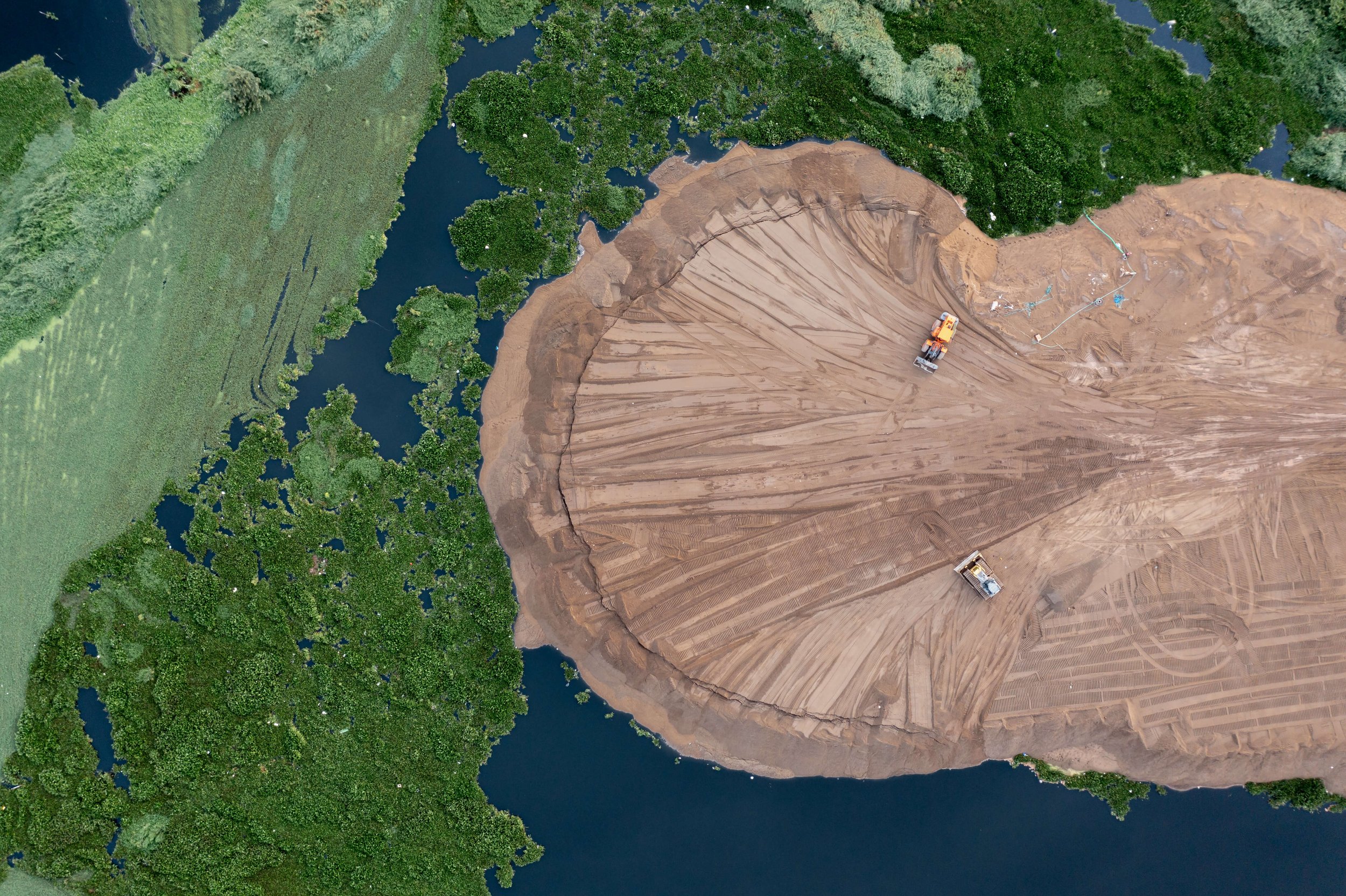
Sand pumped from the Mekong is used to fill in Boeung Tompun, Phnom Penh’s largest wetlands, to make way for a new satellite city. Since the early 2000s, 60% of Phnom Penh’s lakes and 40% of its wetlands have been completely filled in, replaced by major developments including satellite cities, shopping malls and private luxury residences. (Andy Ball/University of Southampton)
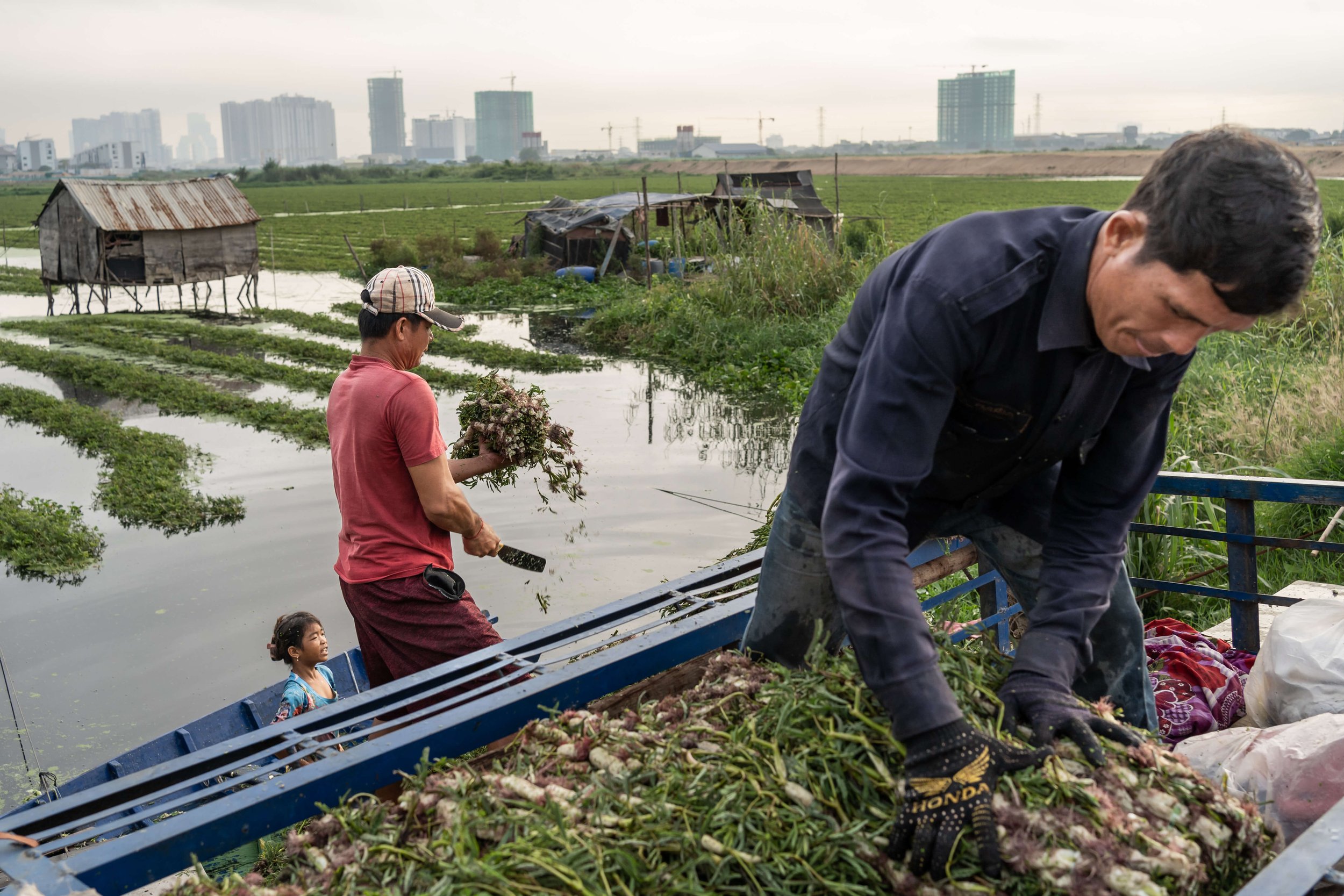
Middlemen load their bikes with water mimosa, a crop that commonly grows on the wetlands, before selling it at one of the city’s bustling markets. Water mimosa, along with a number of other semi-aquatic plants, commonly grows in the wetlands, supporting the livelihoods of many families and helping to filter the constant stream of sewage water from Phnom Penh’s canals. More than 1,000 families live and depend on the Boeung Tompun wetlands for housing, farming and fishing. (Andy Ball/University of Southampton)
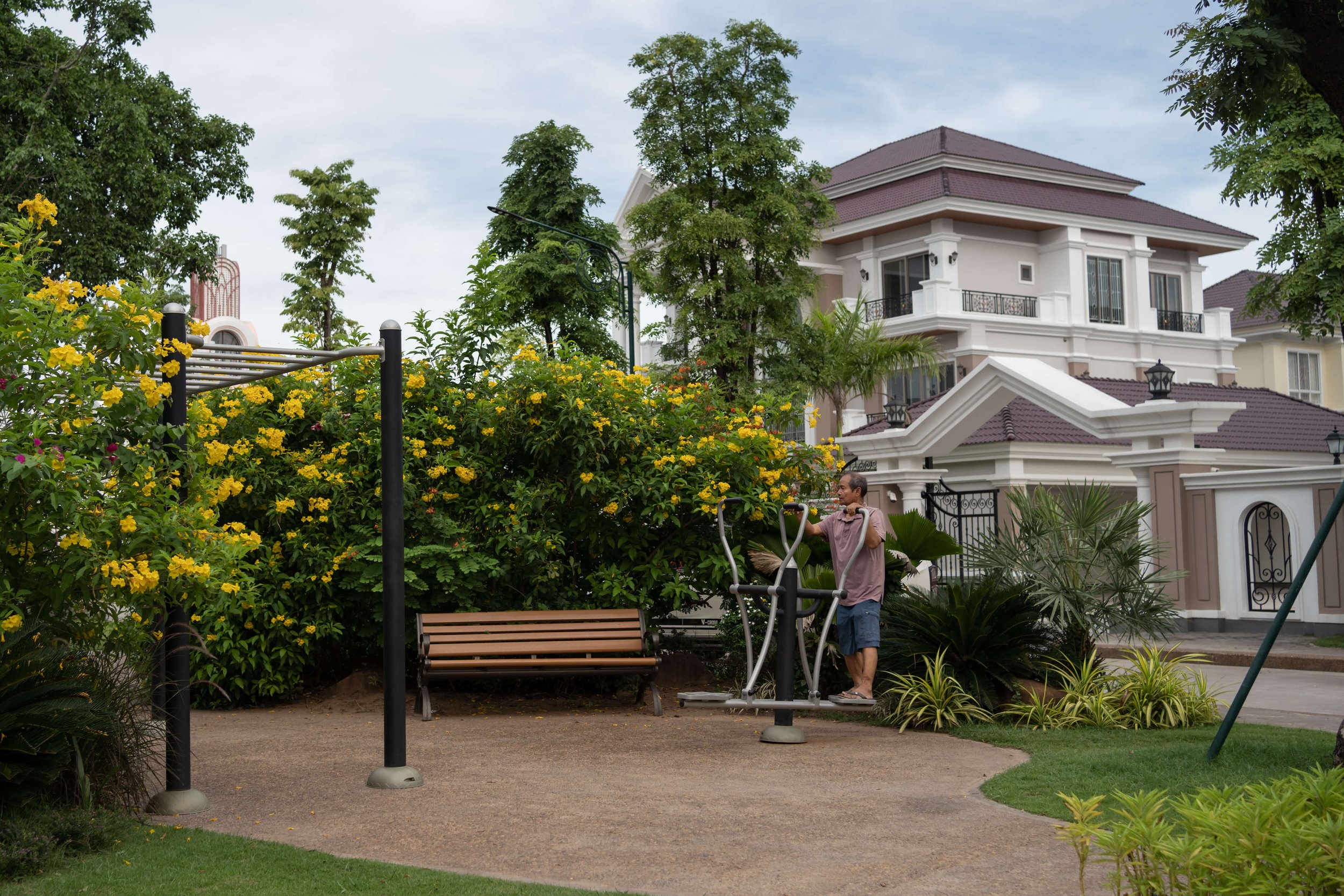
A man exercises at a park in Borey Peng Huoth, one of Phnom Penh’s largest gated communities. Sand pumped from the Mekong and Bassac rivers was used to fill in the Sen Sok and Boeung Reach Sei wetlands, as well as the Boeung Chhouk lake. Last year, sand was also used for the expansion of the borey to fill in farmland that had been used by 241 families since the 1980s, leading to a land dispute between the communities and the company. (Andy Ball/University of Southampton)
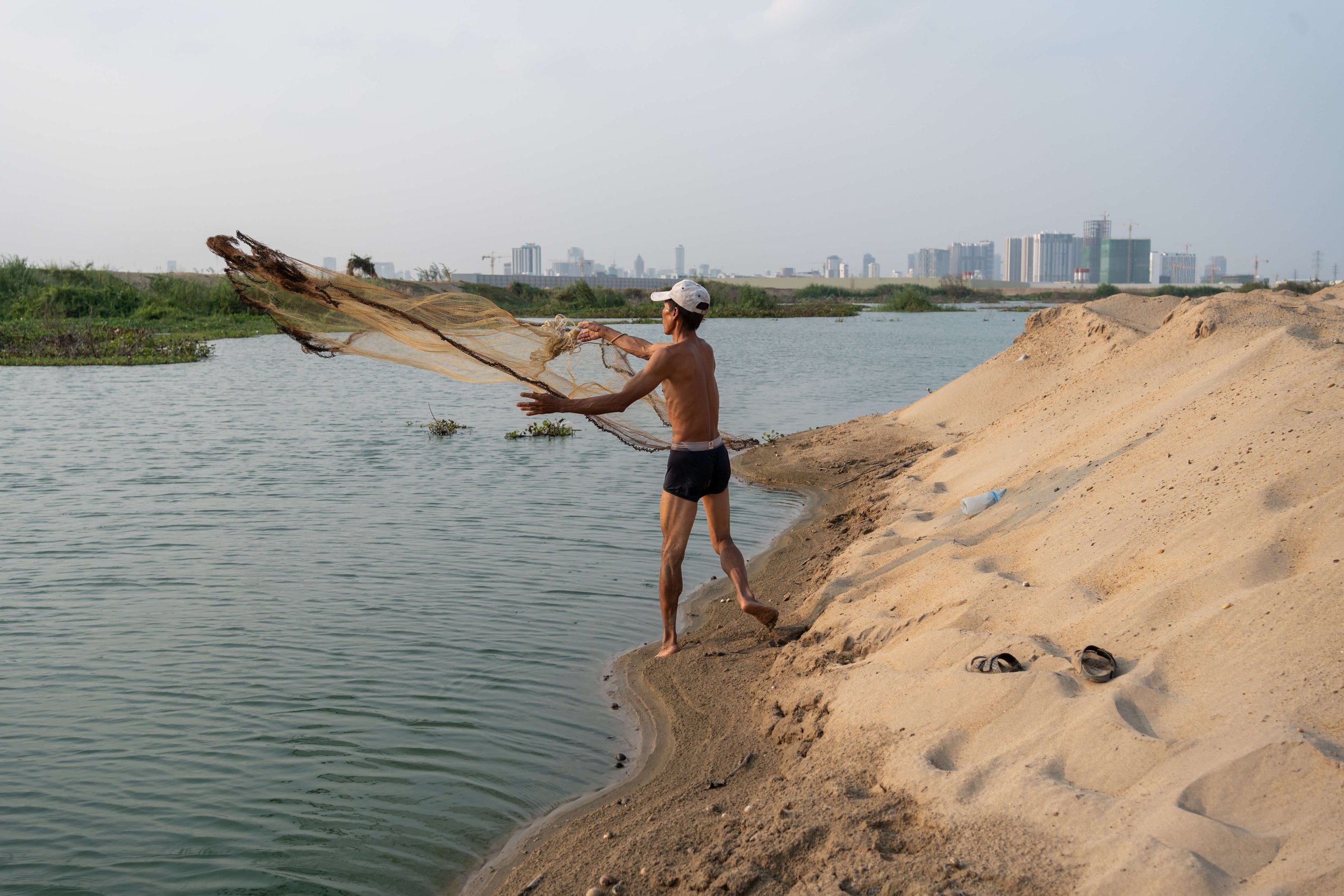
Tayang Sam, a construction worker from Cambodia’s remote Ratanakiri Province, casts his net on sand pumped from the Mekong into the wetlands. Sam has spent the last four years as a bricklayer, constructing a house owned by a member of the wealthy Cambodian elite in a reclaimed part of the wetlands. Four years ago he could catch between 50 and 60 kilograms of fish each day, but now he says there’s “nothing to catch”. (Andy Ball/University of Southampton)
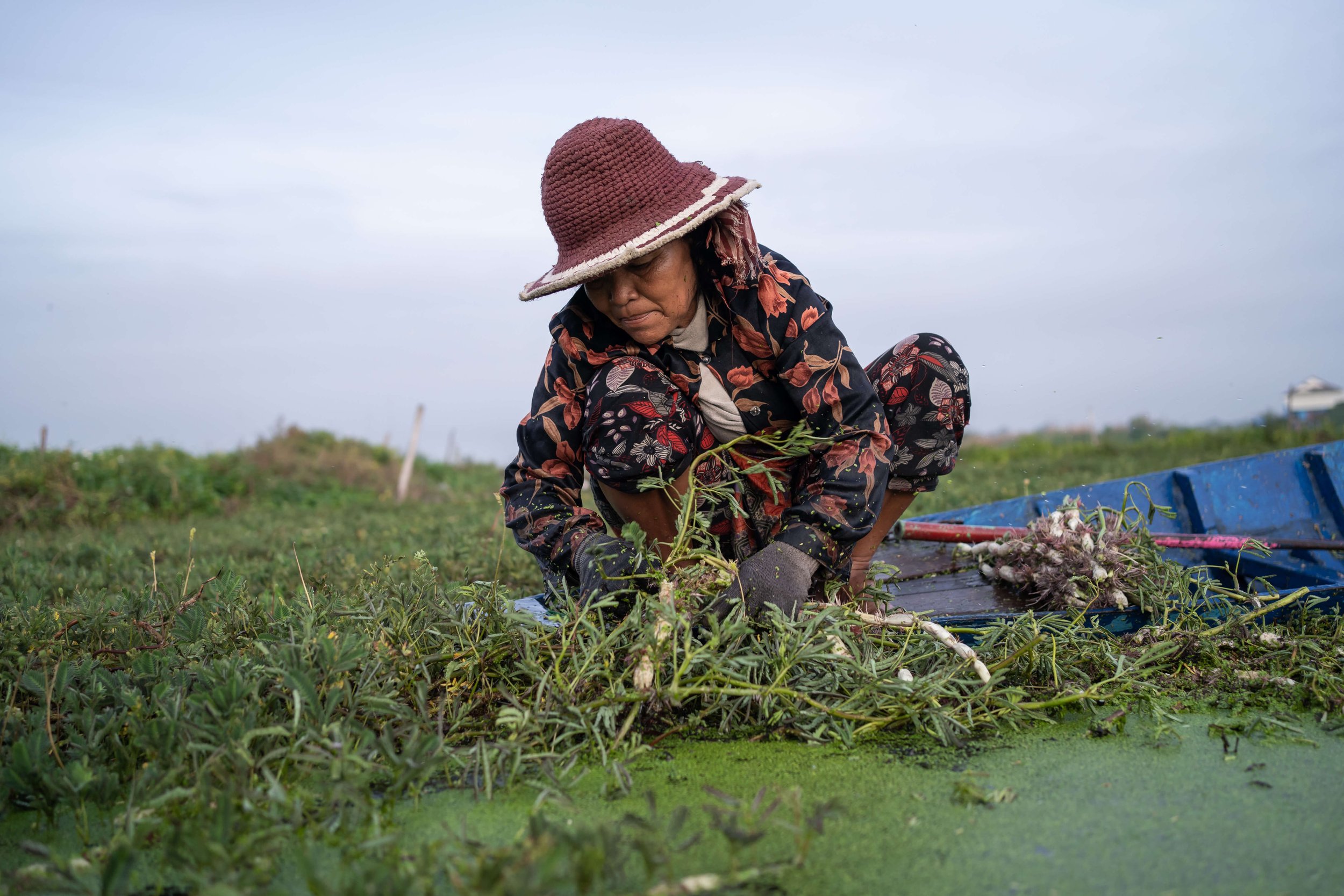
Diet Savon harvests water mimosa, a popular vegetable that commonly grows on the wetlands. Savon has built her life on the wetlands for 20 years but recently has witnessed many of her neighbours leave as it is gradually filled in for a mega development project, preventing them from farming and fishing. (Andy Ball/University of Southampton)
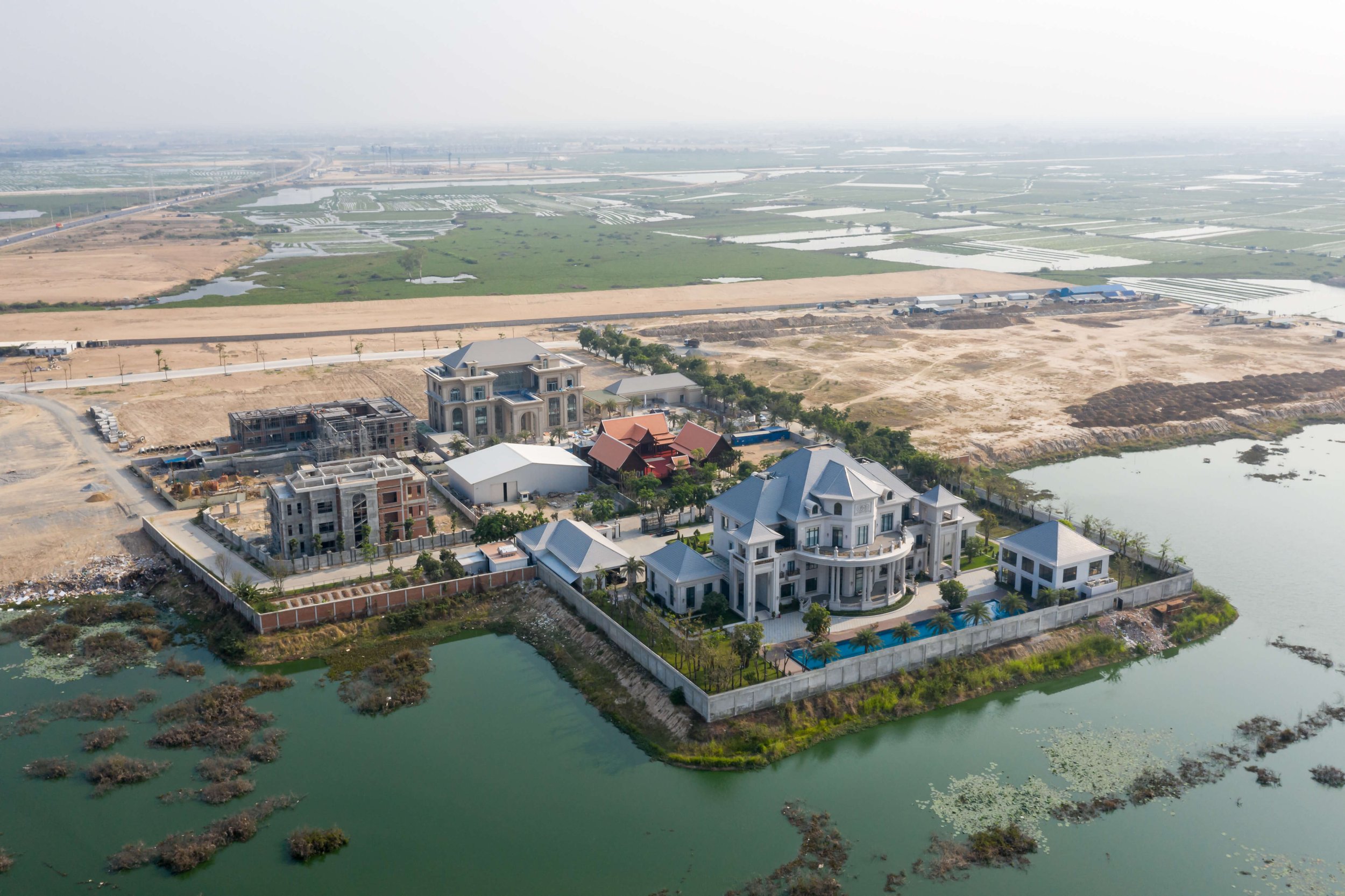
Houses rumoured to belong to Cambodia’s elite are built on a filled in section of the Boeung Tumpun. The wetlands store 70% of the rain and wastewater from Phnom Penh, helping to prevent the city from flooding during the wet season. Numerous species of animals and plants, including endangered fish species, have also been recorded in the lakes and wetlands around Phnom Penh. (Andy Ball/University of Southampton)
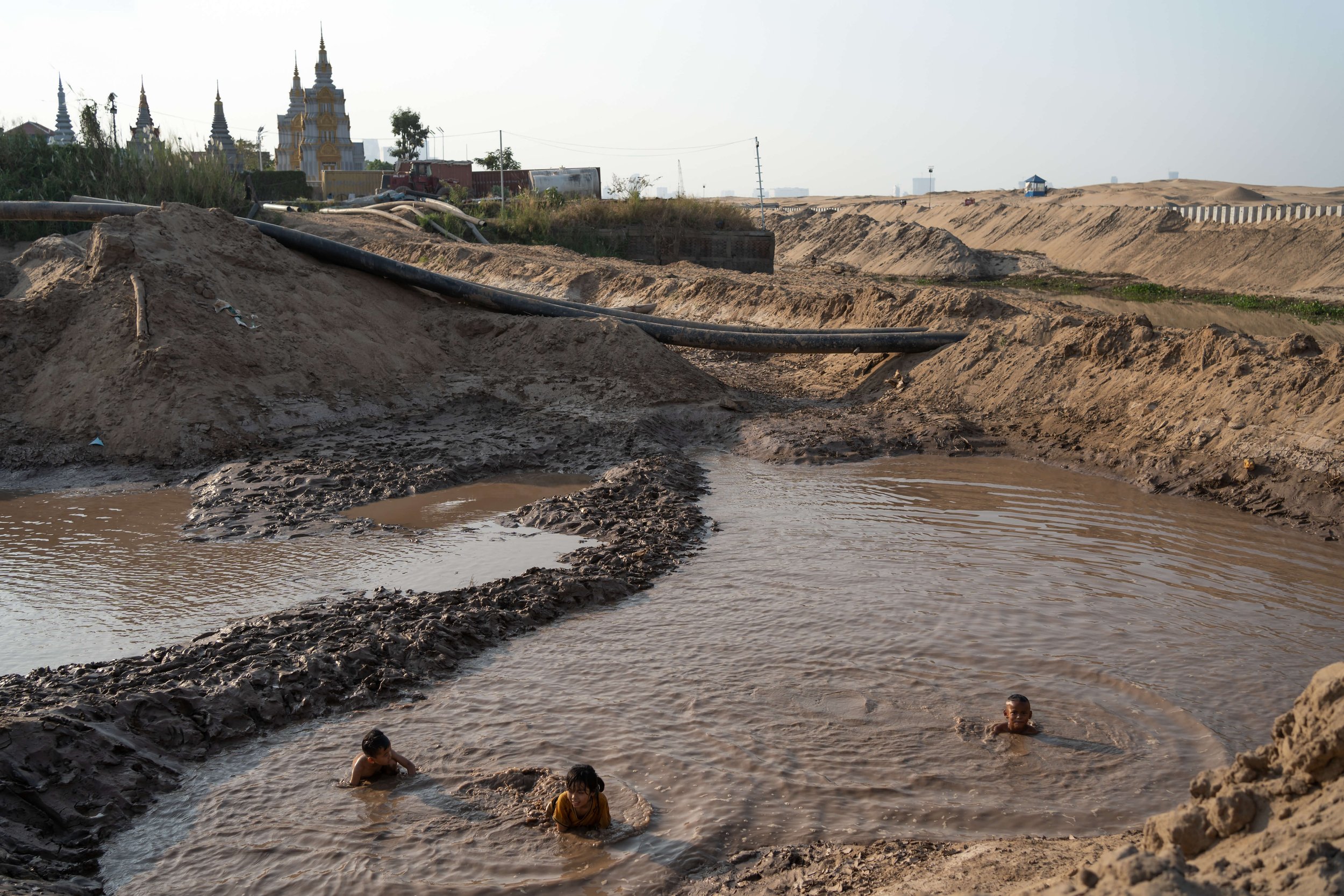
Children play in puddles at a sand deposit site on the outskirts of Phnom Penh. In the background a Buddhist temple sits in front of Koh Norea, a new reclamation project on the Mekong. (Andy Ball/University of Southampton)
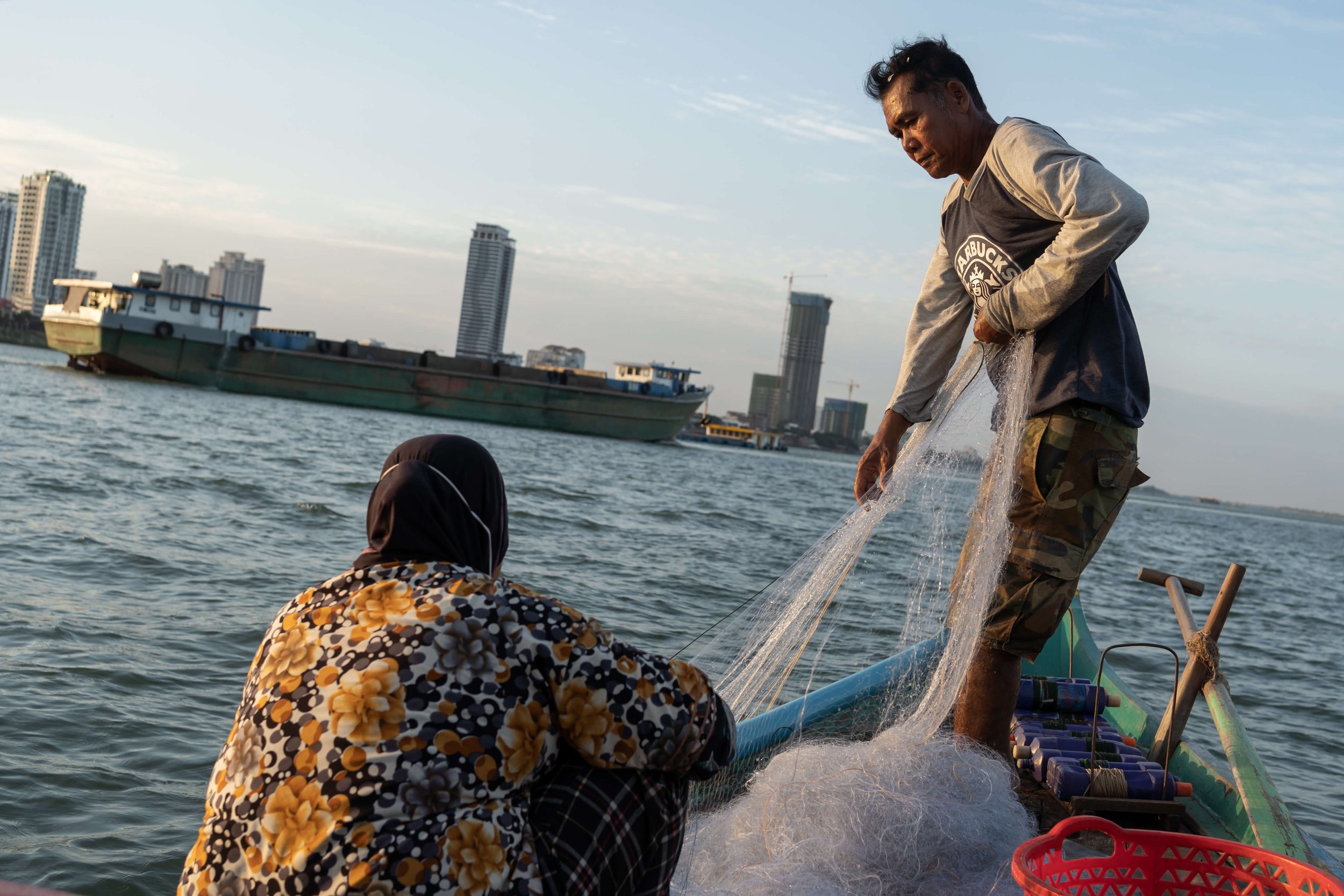
Om Vi (right) and Chip Srey Vas pull up their nets as a sand dredger drives past. They are one of 600,000 Cham people in Cambodia, an ethnic minority considered descendents of the Champa kingdom, who rely on the Mekong River for its fisheries. In 1996, Vi could catch up to 200 kilograms of fish a day, but from 2000 onwards, this was reduced to just 10 kilograms a day. Climate change and upstream dams have heavily impacted the Mekong’s fisheries. In recent years, they’ve also had to face another impact; intense traffic of sand mining barges that often leave their nets damaged. (Andy Ball/University of Southampton)
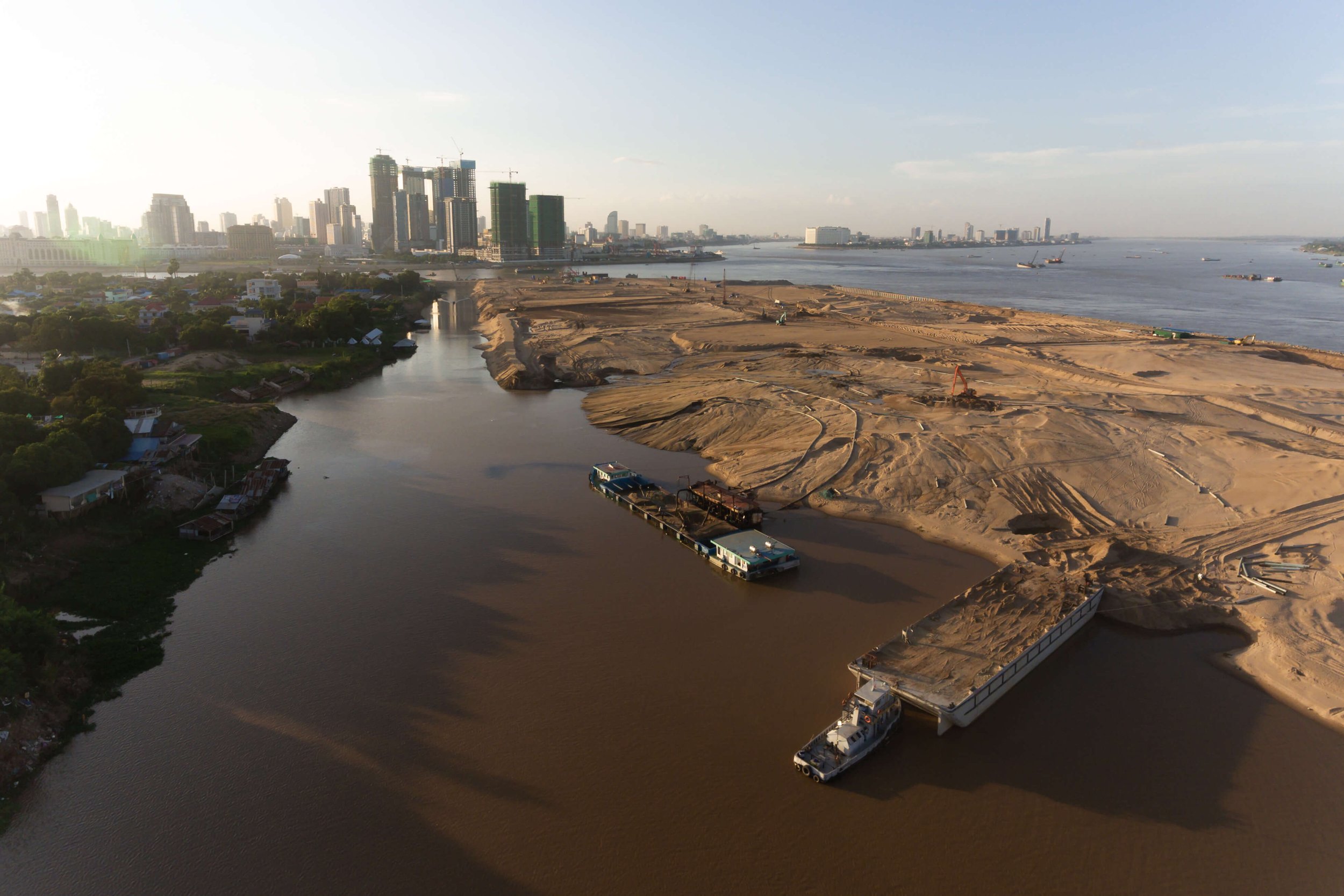
An aerial view of Koh Norea, Phnom Penh’s second artificial island on the Mekong. The mega development, which is yet to publicly produce an Environmental Impact Assessment, has raised concerns among environmentalists and researchers due to the vast quantities of sand required and the as-yet-unknown long-term impacts on the Mekong River’s ecosystem. (Andy Ball/University of Southampton)
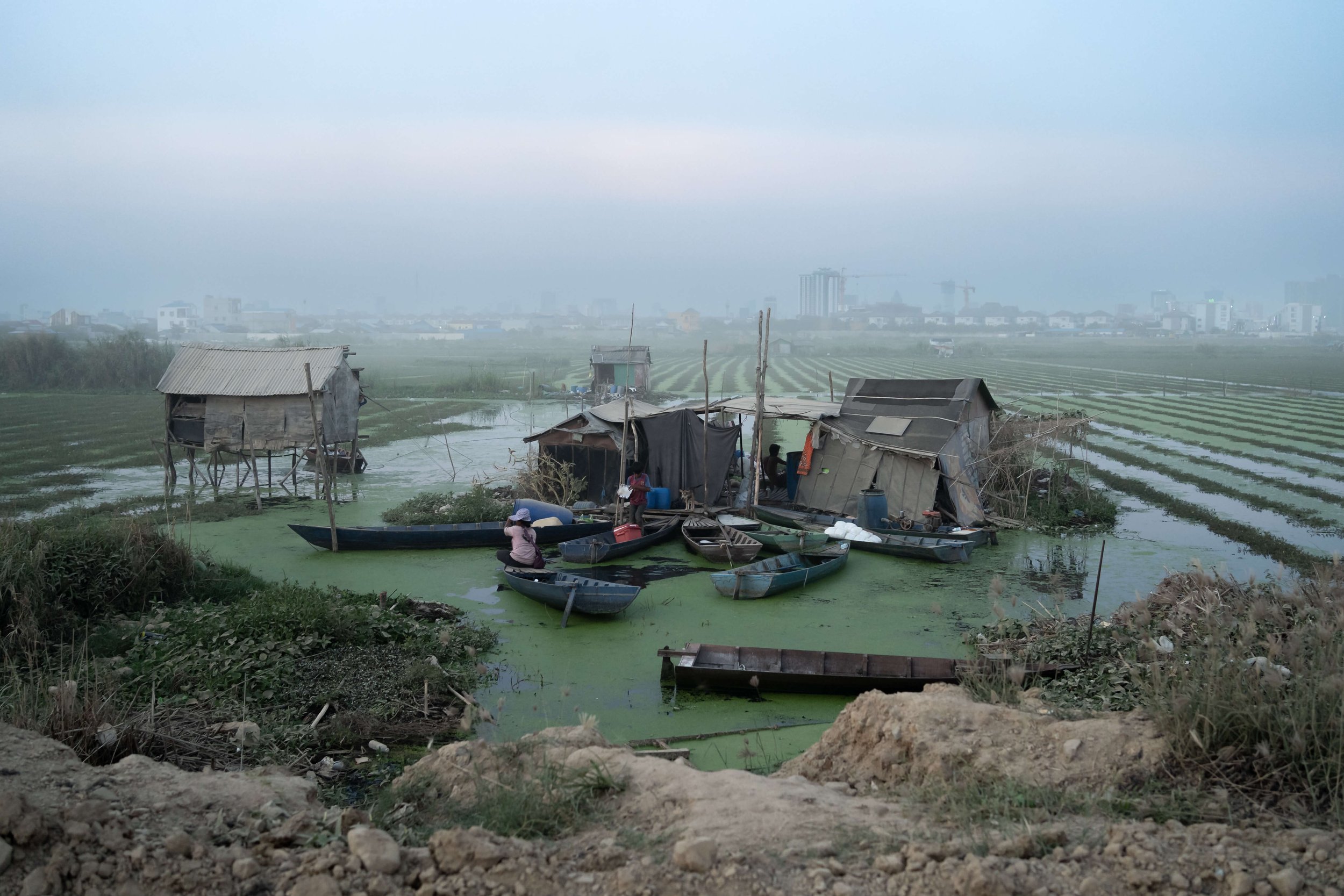
The houses of morning glory and mimosa farmers near a filled in section of the Boeung Tompun wetlands at dusk. As a result of the filling in of much of Phnom Penh’s lakes and wetlands, evictions have become commonplace. Most notably, the filling in of the Boeung Kak lake which saw more than 4,000 families evicted by 2013 to make way for a satellite city, following years of violent land grabs and arrests of prominent community members and activists. (Andy Ball/University of Southampton)
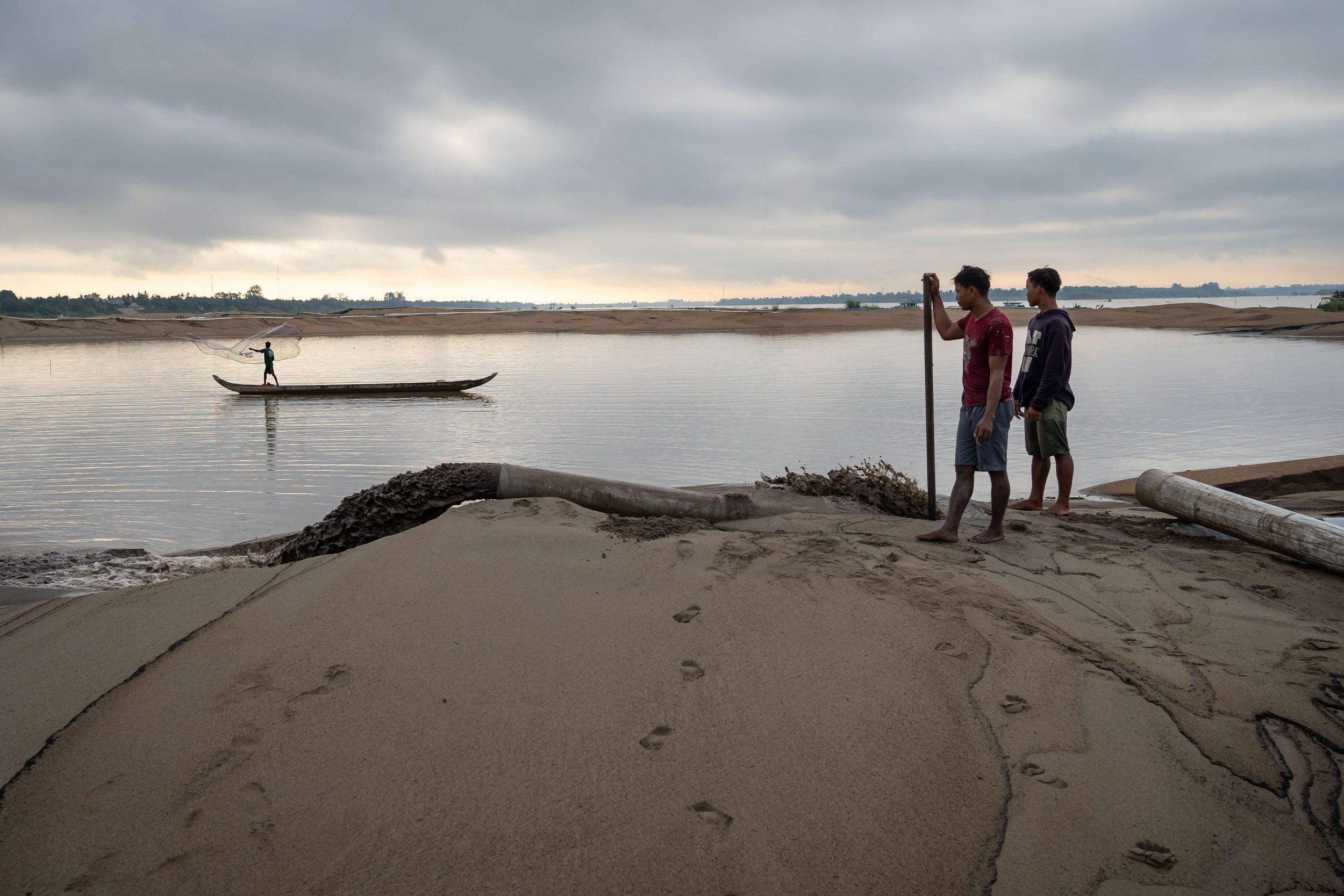
Sand mining workers look on as a fisher casts his net into a temporary lake created by one of Phnom Penh’s latest major land reclamations along the Mekong river. As the city continues to grow, so too does the thirst for sand, leading to an uncertain future for the Mekong River and those who rely on it. (Andy Ball/University of Southampton)